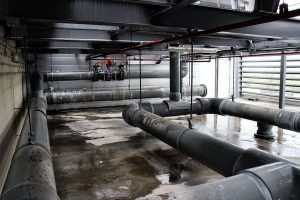A review article this time, “An Overview on the Role of Relative Humidity in Airborne Transmission of SARS-CoV-2 in Indoor Environments“. It’s pretty much all there in the title… they looked at the state of current research and tried to summarize it here, specifically with an eye towards actionable choices for people managing buildings. Abstract …
Microbes in the house Fungal and bacterial growth in floor dust at elevated relative humidity levels — Karen C. Dannemiller — Indoor Air ($6 to rent, $38 to own) Under sustained, elevated building moisture conditions, bacterial and fungal growth occurs. The goal of this study was to characterize microbial growth in floor dust at variable …
Here is a new set of papers that came out in the past week(s) that I posted at MicrobiomeDigest, but that I also wanted to share here. Three of these papers are from BMC’s Microbiome journal, which recently has published several other built environment microbiology papers, so it’s worth checking out. Microbes in buildings Moisture …
(Note: This post was composed in March 2014 but somehow never got published) No environmental measurement is arguably more critical to understanding the indoor environmental factors relevant to the presence of fungi or the potential survival of infectious airborne agents than the moisture measurements. Characterization of the presence of moisture on surfaces, also known as …
Just a quick post — some may find this of interest: ‘Dirty’ air in subdivided flats pose health hazards | South China Morning Post. It reports on a study (not quite sure where it was published, if it was) about bacterial counts from air samples from subdivided living units in Hong Kong public housing. And many …
You can download the database of over 360 publications that report characteristics of the indoor environment along with the microbes found in the studies. Each publication is entered as a record and includes citation, abstract, keywords, organisms, substrates, and environmental conditions as reported by the authors. The database in MS Access format is searchable for …
The Virginia Tech group has published another paper looking at the impacts of indoor environmental conditions on microbes. In this case, it’s potentially a key clue to the on-going search for an explanation to the seasonality of influenza puzzle. It’s not just airborne humidity but also the droplet. composition that matter. Past efforts to find …
An interesting review article from Linsey Marr’s group at Virginia Tech looking at the various factors that might influence virion survival in aerosols. Abstract below: Many airborne viruses have been shown to be sensitive to ambient humidity, yet the mechanisms responsible for this phenomenon remain elusive. We review multiple hypotheses, including water activity, surface inactivation, …

